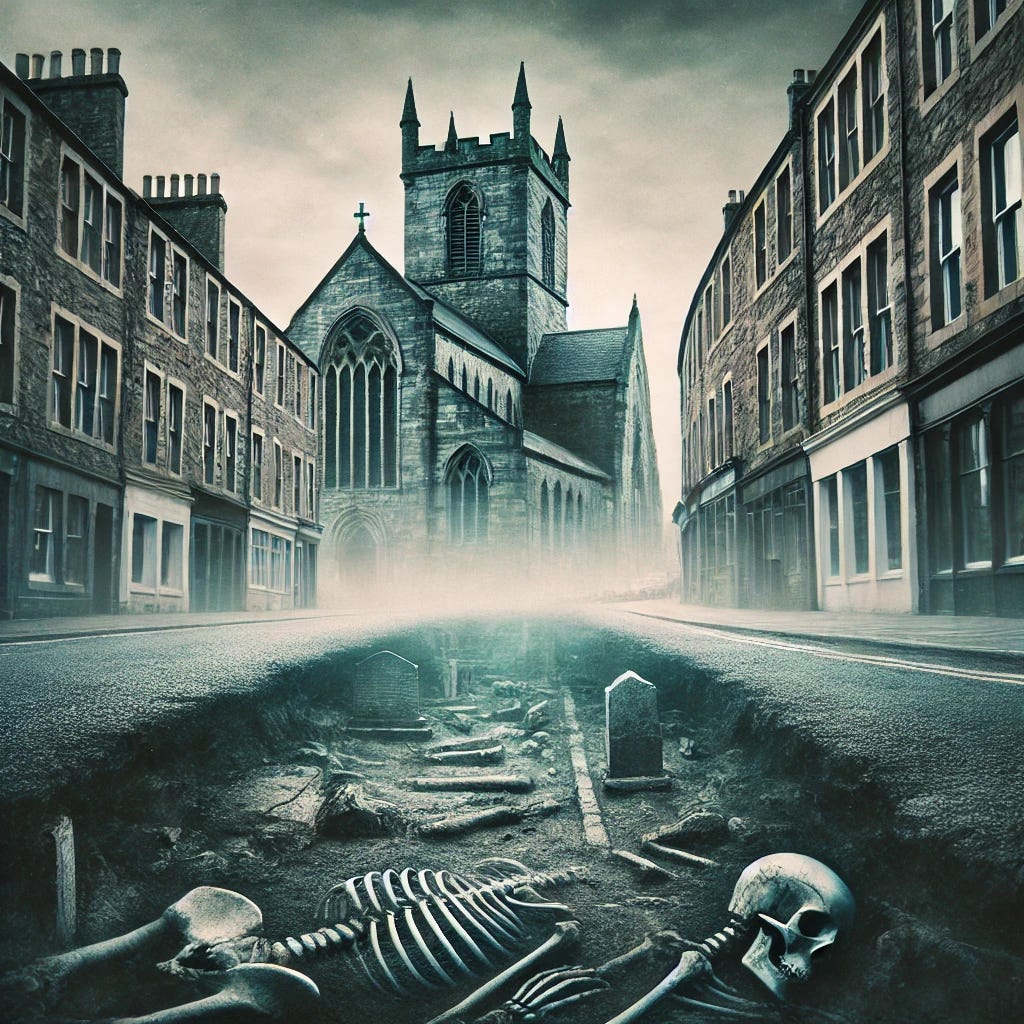In the heart of modern-day Greenock, amidst the streets of shops, homes, and the daily rhythm of town life, lies Virginia Street—a name familiar to locals, yet few realize what ancient mysteries lie buried just beneath its cobbled and paved surface.
At the west corner of Virginia Street, there once stood a small house, unremarkable in appearance but perched atop the site of an ancient and now-vanished chapel. Known in earlier centuries as the Chapel of St. Lawrence, this holy structure gave its name to the bay that opens in front of Greenock—once called the Bay of St. Lawrence. But it wasn’t until the 18th century, when digging the foundation for the aforementioned house, that this quiet corner of town revealed its most haunting secret: human bones.
And not just a few. The construction crew unearthed multiple skeletons, enough to suggest not an isolated burial, but the remnants of a cemetery—a forgotten graveyard, concealed beneath the very soil Greenock had built itself upon.
The Chapel and the Burials
The Chapel of St. Lawrence was once an active place of worship, likely serving a small community or estate in the pre-Reformation period. The discovery of skeletal remains, many interred in what appeared to be proper alignment, indicated that the grounds surrounding the chapel had functioned as a churchyard, used for burials over an extended period.
This would not have been unusual. In medieval Scotland, it was common for chapels to serve both spiritual and practical purposes. Alongside worship, they were places for local gatherings, baptisms, weddings, and final farewells. Burial grounds were sacred spaces, often nestled directly beside the chapels, and carefully maintained.
But something changed. The Reformation, beginning in Scotland in the 1560s, brought radical shifts in religious practice and policy. Many Catholic chapels were dismantled, abandoned, or repurposed. Some disappeared so thoroughly that within a few generations, their locations and even their existence faded from memory. Greenock's chapel at Virginia Street appears to have been one such casualty.
Urban Growth, Forgotten Graves
The 18th and 19th centuries brought dramatic expansion to Greenock. Industry boomed, the port bustled, and the town’s footprint grew rapidly. In the rush to modernize, few gave thought to what lay beneath the ground. When the house was built on the site of the old chapel, no records pointed to its sacred history—until the bones came to light.
Construction halted, at least temporarily. Reports suggest that the bones were human and numerous, likely the remains of townspeople buried centuries earlier. There are no surviving records of what happened to the remains after discovery. Were they reburied with dignity elsewhere? Left beneath the foundations, now mingled with the stone and soil of the new structure? Or perhaps collected and quietly forgotten?
What’s more unsettling is that Virginia Street isn’t unique. Similar discoveries were made at other chapel sites throughout Greenock. At Chapelton, grave markers were found barely a spade-deep beneath the garden soil. The past was never far away—it was simply layered over.
What Lies Beneath?
The story of Virginia Street invites an unsettling question: what else lies beneath Greenock’s streets? How many other chapels, cemeteries, and sacred spaces were buried under the tide of industrial progress and urban development?
It’s a question echoed in cities and towns across the world, but in Greenock, it hits differently. This is a place where history is dense, often compacted into narrow streets and layered housing. Each phase of construction risks brushing up against forgotten epochs. There’s a certain reverence required—an acknowledgment that the dead were once neighbors, and their presence lingers in ways we rarely consider.
Some historians and archaeologists have called for proper surveys of sites like Virginia Street, suggesting there may be more to uncover—not just skeletons, but headstones, relics, and potentially even structures buried beneath the surface. These are not just curiosities; they’re part of the fabric of Greenock’s story, stretching back centuries before ships and steam powered the town into global trade networks.
Living With the Past
Today, Virginia Street is just another part of Greenock—shops, homes, and traffic rolling by without pause. But for those who know the story, there's something eerie yet fascinating about standing at that corner. You might look down at the cobblestones and wonder if beneath your feet lie the foundations of a chapel, the bones of a community, or the last traces of a faith extinguished by history.
It’s a poignant reminder that no matter how much time passes or how much a place changes, the past does not disappear. It merely waits, often silently, until a shovel, a stone, or a curious soul brings it once more into the light.





